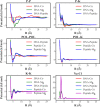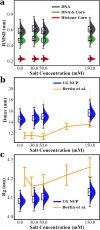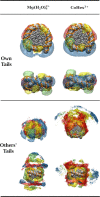A Bottom-Up Coarse-Grained Model for Nucleosome-Nucleosome Interactions with Explicit Ions
- PMID: 35580041
- PMCID: PMC9202350
- DOI: 10.1021/acs.jctc.2c00083
A Bottom-Up Coarse-Grained Model for Nucleosome-Nucleosome Interactions with Explicit Ions
Abstract
The nucleosome core particle (NCP) is a large complex of 145-147 base pairs of DNA and eight histone proteins and is the basic building block of chromatin that forms the chromosomes. Here, we develop a coarse-grained (CG) model of the NCP derived through a systematic bottom-up approach based on underlying all-atom MD simulations to compute the necessary CG interactions. The model produces excellent agreement with known structural features of the NCP and gives a realistic description of the nucleosome-nucleosome attraction in the presence of multivalent cations (Mg(H2O)62+ or Co(NH3)63+) for systems comprising 20 NCPs. The results of the simulations reveal structural details of the NCP-NCP interactions unavailable from experimental approaches, and this model opens the prospect for the rigorous modeling of chromatin fibers.
Conflict of interest statement
The authors declare no competing financial interest.
Figures










Similar articles
-
An advanced coarse-grained nucleosome core particle model for computer simulations of nucleosome-nucleosome interactions under varying ionic conditions.PLoS One. 2013;8(2):e54228. doi: 10.1371/journal.pone.0054228. Epub 2013 Feb 13. PLoS One. 2013. PMID: 23418426 Free PMC article.
-
Multiscale modelling of nucleosome core particle aggregation.J Phys Condens Matter. 2015 Feb 18;27(6):064111. doi: 10.1088/0953-8984/27/6/064111. Epub 2015 Jan 7. J Phys Condens Matter. 2015. PMID: 25563982
-
Multiscale modeling reveals the ion-mediated phase separation of nucleosome core particles.Biophys J. 2024 Jun 4;123(11):1414-1434. doi: 10.1016/j.bpj.2023.10.030. Epub 2023 Oct 31. Biophys J. 2024. PMID: 37915169 Free PMC article.
-
Multiscale coarse-grained modelling of chromatin components: DNA and the nucleosome.Adv Colloid Interface Sci. 2016 Jun;232:36-48. doi: 10.1016/j.cis.2016.02.002. Epub 2016 Feb 18. Adv Colloid Interface Sci. 2016. PMID: 26956528 Review.
-
Cation-induced polyelectrolyte-polyelectrolyte attraction in solutions of DNA and nucleosome core particles.Adv Colloid Interface Sci. 2010 Jul 12;158(1-2):32-47. doi: 10.1016/j.cis.2009.08.002. Epub 2009 Aug 26. Adv Colloid Interface Sci. 2010. PMID: 19758583 Review.
Cited by
-
Studies of the Mechanism of Nucleosome Dynamics: A Review on Multifactorial Regulation from Computational and Experimental Cases.Polymers (Basel). 2023 Apr 1;15(7):1763. doi: 10.3390/polym15071763. Polymers (Basel). 2023. PMID: 37050377 Free PMC article. Review.
-
Coarse-Grained Modeling Using Neural Networks Trained on Structural Data.J Chem Theory Comput. 2023 Oct 10;19(19):6704-6717. doi: 10.1021/acs.jctc.3c00516. Epub 2023 Sep 15. J Chem Theory Comput. 2023. PMID: 37712507 Free PMC article.
-
Genome modeling: From chromatin fibers to genes.Curr Opin Struct Biol. 2023 Feb;78:102506. doi: 10.1016/j.sbi.2022.102506. Epub 2022 Dec 26. Curr Opin Struct Biol. 2023. PMID: 36577295 Free PMC article. Review.
-
Explicit Ion Modeling Predicts Physicochemical Interactions for Chromatin Organization.bioRxiv [Preprint]. 2023 Nov 15:2023.05.16.541030. doi: 10.1101/2023.05.16.541030. bioRxiv. 2023. Update in: Elife. 2024 Jan 30;12:RP90073. doi: 10.7554/eLife.90073. PMID: 37293007 Free PMC article. Updated. Preprint.
-
The impact of charge regulation and ionic intranuclear environment on the nucleosome core particle.J Chem Phys. 2024 Dec 21;161(23):235101. doi: 10.1063/5.0241529. J Chem Phys. 2024. PMID: 39704570
References
MeSH terms
Substances
LinkOut - more resources
Full Text Sources

